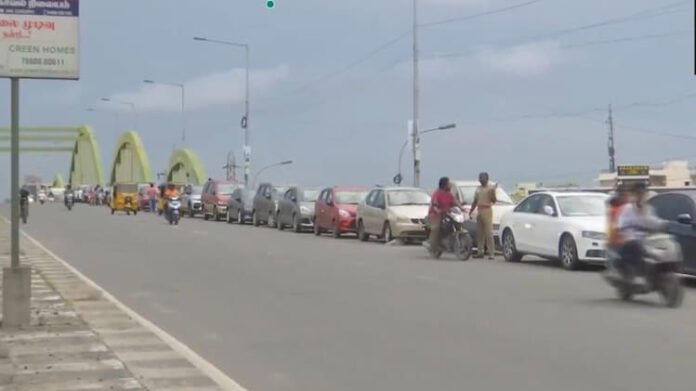Chennai, one of India’s largest metropolitan cities, is once again bracing for heavy rainfall, triggering fears of severe flooding. With the Indian Meteorological Department (IMD) issuing a red alert for heavy to very heavy rainfall in Chennai and its surrounding areas, residents are taking drastic measures to safeguard their properties, especially their vehicles. One of the most striking sights across the city in recent days has been rows of cars parked on flyovers, with residents scrambling to protect their vehicles from flood damage.
The Flooding Threat in Chennai
Chennai, which lies along India’s southeastern coast, is highly vulnerable to floods, especially during the monsoon season and when cyclonic weather conditions develop in the Bay of Bengal. Heavy rainfall often overwhelms the city’s drainage infrastructure, causing waterlogging and severe floods in low-lying areas. In particular, memories of the catastrophic floods in 2015, which devastated large parts of the city, remain vivid in the minds of Chennai’s residents.
In the past few years, the city has witnessed instances of urban flooding even with moderate rainfall, as inadequate stormwater drains, encroachment on water bodies, and poor urban planning exacerbate the situation. As a result, residents have grown increasingly cautious about safeguarding their homes and belongings, including their cars, which are often one of the first casualties when streets turn into rivers.
Why Cars Are Being Parked on Flyovers
For many residents, parking their cars on flyovers during periods of heavy rain has become a strategy born out of necessity. Flyovers, which are elevated above ground level, provide a relatively safe space where vehicles are unlikely to be affected by floodwaters. By parking their cars on these elevated structures, vehicle owners aim to protect them from the damage caused by waterlogging, which can lead to costly repairs or, in worst cases, complete loss of the vehicle.
During previous instances of flooding in Chennai, especially in 2015, many cars were submerged in water, causing damage to engines, interiors, and electronic systems. The cost of repairing a water-damaged vehicle can be exorbitant, often running into lakhs of rupees. For middle-class families, this financial strain can be significant. As such, parking on flyovers is seen as a preventive measure to avoid both the immediate inconvenience and the high cost of damage.
While the practice may appear unorthodox, it is a reflection of the city’s vulnerabilities and residents’ efforts to adapt to a worsening problem. Many areas in Chennai, such as Velachery, T. Nagar, and parts of the IT corridor, are notorious for flooding even after a few hours of heavy rain, making flyovers a safer option for those living in flood-prone zones.
Traffic Disruptions and Safety Concerns
Though residents view parking on flyovers as a necessary precaution, the practice has raised concerns about traffic congestion and safety. Flyovers are designed for the movement of vehicles, not as parking spaces, and blocking them can create bottlenecks, particularly during peak hours or emergencies. The city’s traffic police have taken note of the situation and, while they are sympathetic to the residents’ plight, they have advised caution.
Parking cars on flyovers can impede emergency services, including ambulances and fire trucks, which may need to use these elevated roads to bypass waterlogged streets. In addition, the accumulation of vehicles on flyovers increases the risk of accidents, particularly during periods of low visibility caused by heavy rain. Authorities have urged residents to park their vehicles safely and to avoid blocking crucial stretches of road that may need to be accessed for public safety.
Long-Term Solutions Needed
The sight of cars parked on flyovers is a stark reminder of the larger infrastructure issues that plague Chennai. The city’s drainage system, which has long been a source of concern, is outdated and insufficient to handle the heavy rains brought by monsoons and cyclones. Although the government has made some efforts to improve stormwater drainage and desilt water bodies, progress has been slow, and the impact of urbanization on natural waterways continues to pose challenges.
Experts have pointed out the need for long-term planning, including better urban flood management, stronger enforcement of zoning laws to prevent illegal encroachments on wetlands, and the expansion of green spaces that can absorb excess rainfall. For now, however, residents are left to find their own ways of coping with the threat of flooding, with parking on flyovers being just one example of how they are adapting to the challenges of living in a flood-prone city.
As Chennai prepares for more heavy rain in the coming days, the city’s residents are once again on high alert. Parking cars on flyovers, though unconventional, reflects the growing desperation of people trying to protect their property from flood damage. Until more permanent solutions are put in place to address the city’s flood risks, such makeshift measures are likely to remain a common sight during Chennai’s monsoon season.
